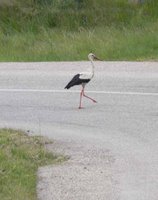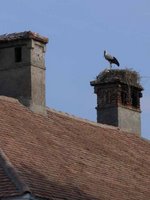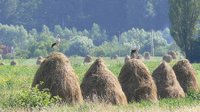 Everywhere we ride, but particularly in villages, electricity poles, and even house chimneys provide shelter for stork families. We watched them initially with excitement in early Spring, when the male and female were busy building their nests with branches, sprigs and hay collected from fields and forests.
Everywhere we ride, but particularly in villages, electricity poles, and even house chimneys provide shelter for stork families. We watched them initially with excitement in early Spring, when the male and female were busy building their nests with branches, sprigs and hay collected from fields and forests.We noticed them again and again as we criss-crossed the country, either perched up on their nests, or foraging for food in marshes and fields. As time passed, we rejoiced in seeing their young peek over the nest to observe the world around them. We also saw them eagerly awaiting much-needed food.

More recently, the sight has changed—now, as we look up at the nests, we notice three or four storks, and by their size alone, we can no longer tell which are the adults and which are the young ones.
This week, in a moment of sheer beauty, we passed by an open field in Transylvania, only to watch the ethereal, fluid flight circles of four storks. They were flying in circles, mostly gliding upward on air currents, then descending, still circularly, only to regain altitude. It became immediately clear that the adult storks were giving flying lessons to the young, teaching them how to climb using warm air currents, how to glide and conserve energy—all the techniques they learned from their parents.
There was something utterly beautiful in the way they were flying—smooth, circular, almost effortless lines. And the realization that these were special moments between the young storks and their parents—moments when knowledge, experience and love were shared and passed-on—created an equally beautiful feeling inside me. And, suddenly, even though I was observing the scene from a rumbling, speeding motorcycle, I felt a sense of stillness, quietness and a pause in time. For a few brief seconds, I almost transcended the flow of time and distance, and wanted to lift and start gliding upward in smooth, flowing lines. Well, the reality of hard pavement whizzing by at high speed is no match for any kind of transcendental meditation. So I refocused my gaze on the task at hand. But, I allowed that inner feeling to linger…
 Here were graceful creatures who travel with the seasons. They fly north toward Romania in the Spring, create life, feed, nurture and protect it, teach it how to fly on its own, and then, when Fall comes, they move south, toward warmer places. The space in-between is filled with seemingly mundane tasks. Yet, it’s those mundane tasks that give meaning to their existence, just as our lives oftentimes find meaning in the simple moments. It is interesting that our lives tend to be summarized, from history’s perspective, in one dash—the dash between our year of birth and our year of death. It’s a short dash, a simple line, a mere symbol adopted to represent the mundane activities that make up our lives, and which, for most of us, will never make the headlines or the history books.
Here were graceful creatures who travel with the seasons. They fly north toward Romania in the Spring, create life, feed, nurture and protect it, teach it how to fly on its own, and then, when Fall comes, they move south, toward warmer places. The space in-between is filled with seemingly mundane tasks. Yet, it’s those mundane tasks that give meaning to their existence, just as our lives oftentimes find meaning in the simple moments. It is interesting that our lives tend to be summarized, from history’s perspective, in one dash—the dash between our year of birth and our year of death. It’s a short dash, a simple line, a mere symbol adopted to represent the mundane activities that make up our lives, and which, for most of us, will never make the headlines or the history books.As I watched the storks fly, round and round, higher and then lower, it dawned on me that these creatures were neither building mansions, companies or empires, nor were they conquering new territories or changing history. They were simply doing what they’ve done for millennia—flying. — BGR

No comments:
Post a Comment